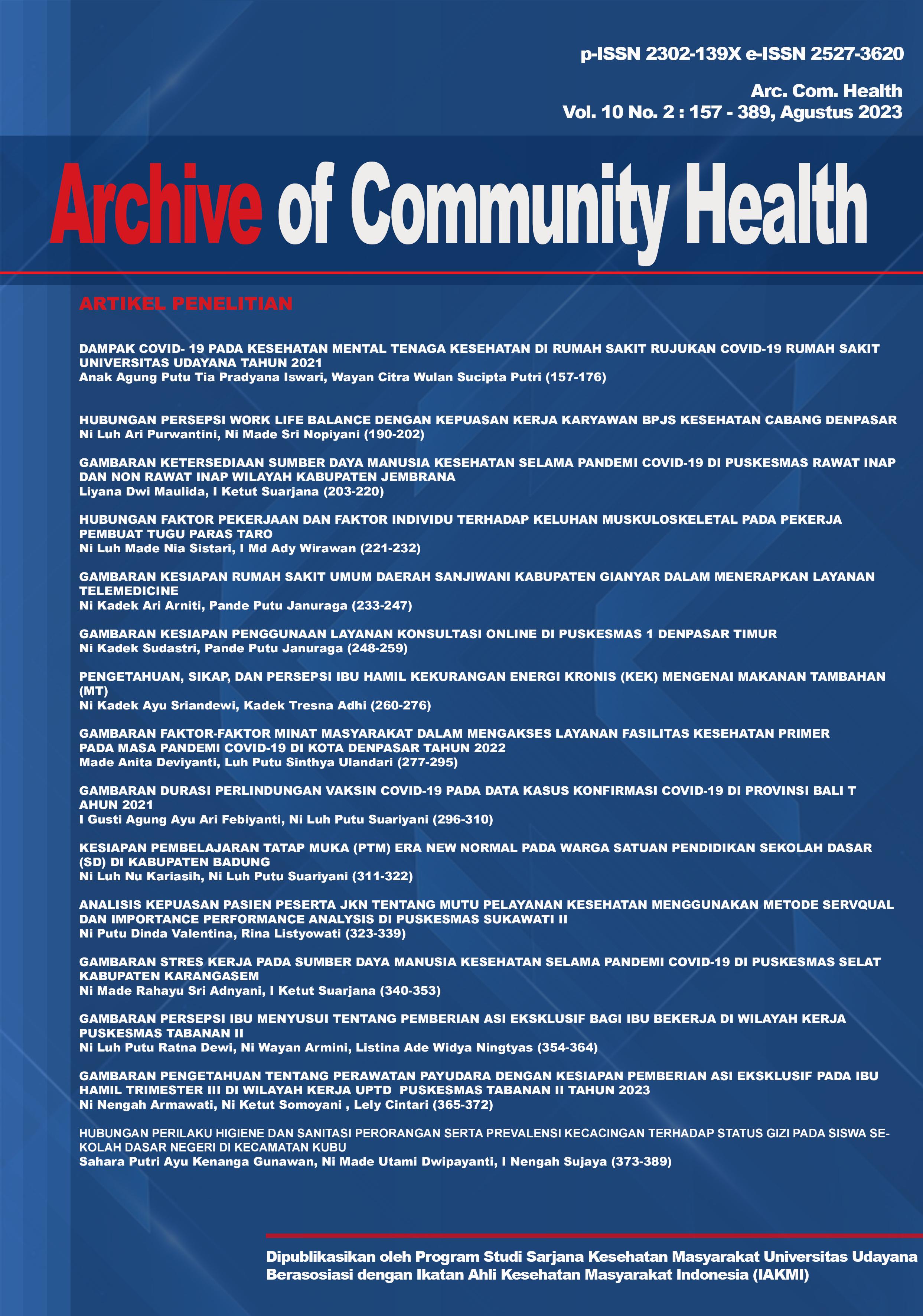GAMBARAN STRES KERJA PADA SUMBER DAYA MANUSIA KESEHATAN SELAMA PANDEMI COVID-19 DI PUSKESMAS SELAT KABUPATEN KARANGASEM
Abstract
ABSTRACT
During the COVID-19 pandemic, Health Human Resources at the Public Health Center are required to perform additional tasks in an effort to overcome the COVID-19 pandemic, but the function of the Public Health Center as primary health service provider must continue achieve the specified targets. This matter puts physical and mental pressure on health human resources at the Selat Public Health Center which can trigger stress. The purpose of this study was to find out the description of work stress in health human resources during the COVID-19 pandemic at the Selat Public Health based on individual characteristics and work-related stressors. This research is an observational study using a cross sectional approach. The sample in this study were all of health human resources at the Selat Public Health Center, totaling 81 respondents, which were obtained through total sampling technique. The results showed that most of the respondents (48.1%) experienced severe work stress during the COVID-19 pandemic. As many as 77.8% of respondents felt a high workload during the COVID-19 pandemic. There is a relationship between gender (p=0.047), education (p=<0.01), and type of worker (p=<0.01), workload (p=<0.01), physical work environment (p= <0.01), interpersonal conflict (p=<0.01), and role conflict (p=<0.01) with work stress during the COVID-19 pandemic. Most of the respondents experienced heavy work stress during the COVID-19 pandemic. It is suggested that the puskesmas can develop policies to manage stress, analyze workload objectively, and provide rewards to increase work motivation.
Keywords: COVID-19, Public Health Center, Health Human Resources, work stress,
ABSTRAK
Di masa pandemi COVID-19, SDM kesehatan di Puskesmas dituntut untuk melakukan tugas tambahan dalam upaya penanggulangan pandemi COVID-19, namun fungsi Puskesmas sebagai penyedia layanan kesehatan primer harus tetap berjalan untuk mencapai target yang ditentukan. Hal tersebut memberikan tekanan fisik maupun mental bagi SDM kesehatan di Puskesmas Selat yang dapat memicu terjadinya stres. Tujuan dari penelitian ini adalah untuk mengetahuai gambaran stres kerja pada SDM kesehatan selama pandemi COVID-19 di Puskesmas Selat berdasarkan karakteristik individu dan stressor terkait pekerjaan. Penelitian ini merupakan penelitian observasional dengan menggunakan pendekatan cross sectional. Sampel dalam penelitian ini adalah seluruh SDM kesehatan di Puskesmas Selat yang berjumlah 81 responden yang didapatkan melalui teknik total sampling. Hasil penelitian menunjukan sebagian besar responden (48,1%) mengalami stres kerja berat selama pandemi COVID-19. Sebesar 77,8% responden merasakan beban kerja tinggi selama pandemi COVID-19. Terdapat hubungan antara jenis kelamin (p=0,047), pendidikan (p=<0,01), dan jenis pekerja (p=<0,01), beban kerja (p=<0,01), lingkungan kerja fisik (p=<0,01), konflik interpersonal (p=<0,01), dan konflik peran (p=<0,01) dengan stres kerja selama pandemi COVID-19. Sebagian besar responden mengalami stres kerja yang berat selama pandemi COVID-19. Disarankan untuk pihak puskesmas dapat mengembangkan kebijakan untuk memanajemen stres, menganalisis beban kerja secara objektif, dan memberikian reward untuk meningkatkan motivasi kerja
Kata kunci: COVID-19, Puskesmas, SDM kesehatan, stres kerja














